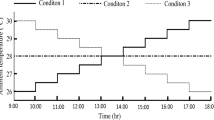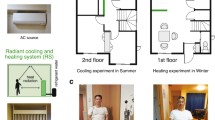Abstract
Subjective estimates of arousal and oral temperature were investigated in a group of young male and female office workers in a constant thermal environment. The measures of arousal were obtained over the period from before rising in the morning until just before sleep in the evening and the results were compared to recently published data in the literature. This comparison indicates a decrease in arousal in this group of subjects and the possible implications of these findings for the artificial control of the thermal environment are discussed.
Similar content being viewed by others
References
ADAM, J.M. and FERRES, H.M. (1954): Observations on oral and rectal temperatures in the humid tropics and in a temperate climate. J. Physiol. (Lond.), 125: 21 P.
COLQUHOUN, W.P. (1971): Circadian variations in mental efficiency. In: Biological Rhythms and Human Performance. W.P. Colquhoun (ed.) Academic, New York, 39–108.
DERMER, M. and BERSCHEID, E. (1972): Self-report of arousal as an indicant of activation level. Behav. Sci., 17: 420–429.
FANGER, P.O. (1973): Assessment of man's thermal comfort in practice. Brit. J. indust. Med., 30: 313–324.
FANGER, P.O., HØJBJERRE, J. and THOMSEN, J.O.B. (1973): Man's preferred ambient temperature during the day. Arch. Sci. Physiol., 27: 395–402.
FANGER, P.O., HØJBJERRE, J. and THOMSEN, J.O.B. (1974): Thermal comfort conditions in the morning and in the evening. Int. J. Biometeor., 18: 16–22.
FANGER, P.O., OSTBERG, O., NICHOLL, A.G. McK., BREUM, N.O. and JERKIN, G.E. (1974): Thermal comfort conditions during day and night. Europ. J. app. Physiol., 33: 255–263.
HALBERG, F., TONG, Y.L. and JOHNSON, E.A. (1965): Circadian system phase — an aspect of temporal morphology; procedures and illustrative examples. In: Cellular Aspects of Biorhythms. A. von Mayersbach (ed.), Springer-Verlag, Berlin and New York.
NEMECEK, J. and GRANDJEAN, E. (1973): Results of an ergonomic investigation of large-space offices. Human Factors, 15: 111–124.
OSTBERG, O. and NICHOLL, E.G.McK. (1973): The preferred thermal conditions for ‘morning’ and ‘evening’ types of subjects during day and night — preliminary results. Build. International, 6: 147–157.
WYON, D.P., ASGEIRSDOTTIR, T., KJERULF-JENSEN, P. and FANGER, P.O. (1973): The effects of ambient temperature swings on comfort performance and behaviour. Arch. Sci. physiol., 27: 441–458.
Author information
Authors and Affiliations
Rights and permissions
About this article
Cite this article
Thorne, R.H., Purcell, A.T. Environmental effects on the subjective perception of level of arousal and the human body temperature rhythm. Int J Biometeorol 20, 318–324 (1976). https://doi.org/10.1007/BF01553589
Received:
Issue Date:
DOI: https://doi.org/10.1007/BF01553589




